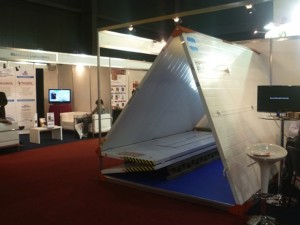In Buenos Aires, foldable housing for disaster relief

BUENOS AIRES -- Like many big ideas, Matías Alter and Matías Carrizo's involved a late-night dinner and a napkin doodle. Four years ago, the two architects, friends since their time at the University of Buenos Aires and partners in the 2M Arquitectos design firm, were working on a new disaster relief housing design for a competition when the proverbial inventor's napkin came out.
"We were talking and drawing and pa pa pa there was the idea for foldable houses," says Carrizo, 36.
That napkin idea became Modularflex, a foldable modular housing company, launched at the 2012 Expo Logisti-k, a trade show in Buenos Aires.

Designing modular and disaster relief housing is very trendy these days, especially in the wake of Katrina and the earthquakes in Chile and Haiti. Systems like QuickHab, House Arc and AbleNook have attracted notice for their innovative, attractive designs. But when Alter and Carrizo came up with the idea for foldable dwellings, there were still two glaring problems with most modular housing used for disaster relief and in hard-to-reach mining camps and the like: First, the designs either came disassembled, which meant that tradesman had to be on hand to build them. Or they came pre-built, which meant that they took up loads of space and required special cranes to install.
"The original idea was to make something fast, something easy to put together and easy to transport," says Alter, 35.
So, the friends thought, what if you designed modular boxes with a hinge halfway up the wall, so they could be collapsed like accordions and stacked on the back of a pickup truck?
"With one truck, you can carry six or seven of these in the space of one container, because they are foldable," says Carrizo. "When we went to the expo, we put four on a Sprinter, the equivalent of two 20-foot containers."
The materials and construction of the Modularflex modules is fairly standard. As is common in other modular units and panelized housing (dwellings shipped in panels and then assembled), Modularflex's modules are made of insulated thermal panels much like the walls of a supermarket cold storage room. This means that they can used in temperatures ranging from -5 to 120 Fahrenheit, Carrizo says. The units, which can be connected to create larger dwellings, hospitals, warehouses and the like, can be customized with doors or windows; the basic module comes with electrical wiring and LED lighting.
But the folding nature of the modules makes them unique, says Don Carlson, who has owned the industry trade journal Automated Builder Magazine since 1974. Because the units are foldable, the 1,000-pound modules can be put into place with a forklift instead of a crane. Then, by pushing and locking the hinges on one wall, and then the other, Alter says that two or three people can have a module up in under half an hour.
"I've never heard of any unit you could build that quick," says Carlson. Normally, in emergency housing situations, he says, "You have to do a lot of work at the job site. You have to snap it all together, usually with pneumatic nailing tools."
As with many Argentine inventions, Modularflex's idea and construction style had a lot to do with Argentina's limitations.
"Here in Argentina, train transport is not that common. Transportation is done with trucks, which has high financial and ecological costs. What's different about us, besides being foldable, is that someone, with one truck, can take more than one," Alter says.
Carrizo gives the example of a mining company in Argentina that last year transported ten containers from Buenos Aires to a mining camp in San Juan, near the Chilean border. Each truck moved one container and cost the company 20,000 pesos (about $4,000), for a total transport bill of 200,000 pesos. "With this system, you save 160,000 pesos, because with two trucks you take them all," he says.
The use of readily available materials is also typically Argentine, as economic limitations and trade barriers often make it hard to get the newest products. As Argentine industrial design veteran Ricardo Blanco noted in a recent SmartPlanet piece, in Argentine design, "One makes [the product] with the materials at hand. There’s no worry about inventing materials."
Today, Carrizo says the company is in the early stages of negotiating deals with mining companies as well as with the Argentine military. A basic 80-square-foot Modularflex module costs 38,000 pesos (about $7,600 at the current exchange rate).
This post was originally published on Smartplanet.com
